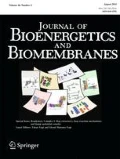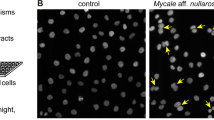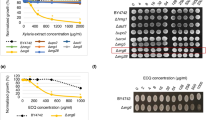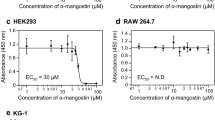Abstract
Studies have been carried out on the effects of the phenyl glycoside myconoside, extracted from the relict, Balkan endemic resurrection plant Haberlea rhodopensis on the plasma membrane structural organization and the actin cytoskeleton. Because the plasma membrane is the first target of exogenous bioactive compounds, we focused our attention on the influence of myconoside on the membrane lipid order and actin cytoskeleton in human lung adenocarcinoma A549 cells, using fluorescent spectroscopy and microscopy techniques. We found that low myconoside concentration (5 μg/ml) did not change cell viability but was able to increase plasma membrane lipid order of the treated cells. Higher myconoside concentration (20 μg/ml) inhibited cell viability by decreasing plasma membrane lipid order and impairing actin cytoskeleton. We hypothesize that the observed changes in the plasma membrane structural organization and the actin cytoskeleton are functionally connected to cell viability. Biomimetic membranes were used to demonstrate that myconoside is able to reorganize the membrane lipids by changing the fraction of sphingomyelin-cholesterol enriched domains. Thus, we propose a putative mechanism of action of myconoside on A549 cells plasma membrane lipids as well as on actin filaments in order to explain its cytotoxic effect at high myconoside concentration.








Similar content being viewed by others
Data availability
Data are available from the corresponding author upon reasonable request and deposited on the institution website of the corresponding authors (http://biomed.bas.bg/bg/).
References
Amaro M, Reina F, Hof M, Eggeling C, Sezgin E (2016) Laurdan and Di-4-ANEPPDHQ probe different properties of the membrane. https://doi.org/10.1101/076752
Bakht O, Pathak P, London E (2007) Effect of the structure of lipids favoring disordered domain formation on the stability of cholesterol-containing ordered domains (lipid rafts): identification of multiple raft-stabilization mechanisms. Biophys J 93(12):4307–4318. https://doi.org/10.1529/biophysj.107.114967
Bloch K (1991) Cholesterol: evolution of structure and function. In: Vance DE, Vance JE (eds) Biochemistry of lipids, lipoproteins and membranes, vol 20, series new comprehensive biochemistry (Meuberger A, Van Deenen LLM, general eds). Elsevier Science Publishers, Amsterdam, pp 363–381. https://doi.org/10.1016/S0167-7306(08)60340-3
Bonarska-Kujawa D, Pruchnik H, Oszmiański J, Sarapuk J, Kleszczyńska H (2011) Changes caused by fruit extracts in the lipid phase of biological and model membranes. Food biophysics 6:58–67. https://doi.org/10.1007/s11483-010-9175-y
Butler CE, Wheeler G, Graham J, Tyler KM (2013) Visual discrimination of membrane domains in live cells by Widefield microscopy. In Mély Y, Duportail G (Eds.), Fluorescent methods to study biological membranes (pp. 163–184). Springer Berlin
Cees D, Driessen A, Recourt K (2001) The uncoupling efficiency and affinity of flavonoids for vesicles. Biochem Pharmacol 60:1593–1600. https://doi.org/10.1016/S0006-2952(00)00488-3
Colin D, Limagne E, Jeanningros S, Jacquel A, Lizard G, Athias A et al (2011) Endocytosis of resveratrol via lipid rafts and activation of downstream signaling pathways in cancer cells. Cancer Prev Res 4(7):1095–1106
Colomer R, Sarrats A, Lupu R, Puig T (2017) Natural polyphenols and their synthetic analogs as emerging anticancer agents. Curr Drug Targets 18(2):147–159
Dell’Acqua G, Schweikert K (2012) Skin benefits of a myconoside-rich extract from resurrection plant Haberlea rhodopensis. Int J Cosmet Sci 34(2):132–139. https://doi.org/10.1111/j.1468-2494.2011.00692.x
Delmas D, Rebe C, Micheau O, Athias A, Gambert P, Grazide S, ... Solary E (2004) Redistribution of CD95, DR4 and DR5 in rafts accounts for the synergistic toxicity of resveratrol and death receptor ligands in colon carcinoma cells. Oncogene 23: 8979–8986
Delmas D, Aires V, Colin DJ, Limagne E, Scagliarini A, Cotte AK, Ghiringhelli F (2013) Importance of lipid microdomains, rafts, in absorption, delivery, and biological effects of resveratrol. Ann N Y Acad Sci, 90–97
Desouza M, Gunning PW, Stehn JR (2012) The actin cytoskeleton as a sensor and mediator of apoptosis. Bioarchitecture 2(3):75–87. https://doi.org/10.4161/bioa.20975
Escribá PV, González-Ros JM, Goñi FM, Kinnunen PK, Vigh L, Sánchez-Magraner L et al (2008) Membranes: a meeting point for lipids, proteins and therapies. J Cell Mol Med 12(3):829–875. https://doi.org/10.1111/j.1582-4934.2008.00281.x
Forstner MB, Yee CK, Parikh AN, Groves JT (2006) Lipid lateral mobility and membrane phase structure modulation by protein binding. J Am Chem Soc 128(47):15221–15227. https://doi.org/10.1021/ja064093h
Gechev TS, Hille J, Woerdenbag HJ, Benina M, Mehterov N, Toneva V et al (2014) Natural products from resurrection plants: potential for medical applications. Biotechnol Adv 32(6):1091–1101. https://doi.org/10.1016/j.biotechadv.2014.03.005
Georgiev YN, Ognyanov MH, Denev PN (2020) The ancient Thracian endemic plant Haberlea rhodopensis Friv. And related species: a review. J Ethnopharmacol 249:112359. https://doi.org/10.1016/j.jep.2019.112359
Georgieva R, Koumanov K, Momchilova A, Tessier C, Staneva G (2010) Effect of sphingosine on domain morphology in giant vesicles. J Colloid Interface Sci 350(2):502–510. https://doi.org/10.1016/j.jcis.2010.07.022
Georgieva R, Mircheva K, Vitkova V, Balashev K, Ivanova T, Tessier C et al (2016) Phospholipase A2-induced remodeling processes on liquid-ordered/liquid-disordered membranes containing docosahexaenoic or oleic acid: a comparison study. Langmuir 32(7):1756–1770. https://doi.org/10.1021/acs.langmuir.5b03317
Havsteen B (2002) The biochemistry and medical significance of the flavonoids. Pharmacol Ther 96:67–202. https://doi.org/10.1016/S0163-7258(02)00298-X
Hayrabedyan S, Todorova K, Zasheva D, Moyankova D, Georgieva D, Todorova J, Djilianov D (2013) Haberlea Rhodopensis has potential as a new drug source based on its broad biological modalities. Biotechnol Biotechnol Equip 27(1):3553–3560. https://doi.org/10.5504/BBEQ.2012.0112A
Head BP, Patel HH, Roth DM, Murray F, Swaney JS, Niesman IR et al (2006) Microtubules and actin microfilaments regulate lipid raft/caveolae localization of adenylyl cyclase signaling components. J Biol Chem 281(36):26391–26399. https://doi.org/10.1074/jbc.M602577200
Head BP, Patel HH, Insel PA (2014) Interaction of membrane/lipid rafts with the cytoskeleton: impact on signaling and function: membrane/lipid rafts, mediators of cytoskeletal arrangement and cell signaling. Biochim Biophys Acta 1838(2):532–545. https://doi.org/10.1016/j.bbamem.2013.07.018
Hendrich A (2006) Flavonoid-membrane interactions: possible consequences for biological effects of some polyphenolic compounds. Acta Pharmacol Sin 27:27–40. https://doi.org/10.1111/j.1745-7254.2006.00238.x
Hutchinson, S., Battaglia, S., Røberg-Larsen, H., Hughes, T., & Thorne, J. (2018). Cholesterol metabolism and chemo-resistance in breast cancer
Ionescu D, Margină D, Ilie M, Iftime A, Ganea C (2013) Quercetin and epigallocatechin-3-gallate effect on the anisotropy of model membranes with cholesterol. Food Chem Toxicol 61:94–100. https://doi.org/10.1016/j.fct.2013.03.007
Kondeva-Burdina M, Zheleva-Dimitrova D, Nedialkov P, Girreser U, Mitcheva M (2013) Cytoprotective and antioxidant effects of phenolic compounds from Haberlea rhodopensis Friv. (Gesneriaceae) Pharmacog Mag 9(36):294–301. https://doi.org/10.4103/0973-1296.117822
Kusumi A, Suzuku K (2005) Toward understanding the dynamics of membrane-raft-based molecular interactions. Biochim Biophys Acta 1746:234–251
Michel V, Bakovic M (2007) Lipid rafts in health and disease. Biol Cell 99(3):129–140. https://doi.org/10.1042/bc20060051
Mihaylova D, Bahchevanska S, Toneva V (2013) Examination of the antioxidant activity of Haberlea Rhodopensis leaf extracts and their phenolic constituents. J Food Biochem 37(3):255–261. https://doi.org/10.1111/j.1745-4514.2011.00609.x
Mladenov P, Finazzi G, Bligny R, Moyankova D, Zasheva D, Boisson A-M, ... Djilianov D (2015) In vivo spectroscopy and NMR metabolite fingerprinting approaches to connect the dynamics of photosynthetic and metabolic phenotypes in resurrection plant Haberlea rhodopensis during desiccation and recovery. Front Plant Sci 6. https://doi.org/10.3389/fpls.2015.00564
Moyankova D, Mladenov P, Berkov S, Peshev D, Georgieva D, Djilianov D (2014) Metabolic profiling of the resurrection plant Haberlea rhodopensis during desiccation and recovery. Physiol Plant 152. https://doi.org/10.1111/ppl.12212
Neves A, Nunes C, Reis S (2015) New insights on the biophysical interaction of resveratrol with biomembrane models: relevance for its biological effects. J Phys Chem B 119. https://doi.org/10.1021/acs.jpcb.5b05419
Owen DMRC, Magenau A, Abu-Siniyeh A, Gaus K (2011) Quantitative imaging of membrane lipid order in cells and organisms. Nat Protoc 7:24–35. https://doi.org/10.1038/nprot.2011.419
Pakiet, Kobiela (2019) Changes in lipids composition and metabolism in colorectal cancer: a review. 18(1): 29. https://doi.org/10.1186/s12944-019-0977-8
Pakiet A, Kobiela J, Stepnowski P, Sledzinski T, Mika A (2019) Changes in lipids composition and metabolism in colorectal cancer: a review. Lipids Health Dis 18(1):1–21
Popov B, Georgieva S, Gadjeva V (2011) Modulatory effects of total extract of Haberlea rhodopensis against the cyclophosphamide induced genotoxicity in rabbit lymphocytes in vivo. Trakia J Sci 9(1):51–57
Saotome K, Morita H, Umeda M (1989) Cytotoxicity test with simplified crystal violet staining method using microtitre plates and its application to injection drugs. Toxicol in Vitro 3(4):317–321. https://doi.org/10.1016/0887-2333(89)90039-8
Simons K, Ikonen E (1997) Functional rafts in cell membranes. Nature 387(6633):569–572. https://doi.org/10.1038/42408
Sirk TW, Brown EF, Sum AK, Friedman M (2008) Molecular dynamics study on the biophysical interactions of seven green tea catechins with lipid bilayers of cell membranes. J Agric Food Chem 56(17):7750–7758. https://doi.org/10.1021/jf8013298
Suga K, Umakoshi H (2013) Detection of nanosized ordered domains in DOPC/DPPC and DOPC/Ch binary lipid mixture systems of large unilamellar vesicles using a TEMPO quenching method. Langmuir 29(15):4830–4838. https://doi.org/10.1021/la304768f
Tarahovsky Y (2008) Plant polyphenols in cell-cell interaction and communication. Plant Signal Behav 3(8):609–611
Todorova R, Atanasov A (2015) Haberlea rhodopensis: pharmaceutical and medical potential as a food additive. Nat Prod Res 30:1–23. https://doi.org/10.1080/14786419.2015.1028058
Topouzova T, Elena S, Stoitsova S (2012) Bacterial interference with host epithelial junctional complexes: probiotic bacteria vs. a/E lesion-forming Escherichia coli. J BioSci Biotechnol 1:83–89
Trosko J (2006) Dietary modulation of the multistage, multimechanisms of human carcinogenesis: effects on initiated stem cells and cell-cell communication. Nutr Cancer 54:102–110
Tsuchiya H (2015) Membrane interactions of phytochemicals as their molecular mechanism applicable to the discovery of drug leads from plants. Molecules 20(10):18923–18966. https://doi.org/10.3390/molecules201018923
Viola A, Gupta N (2007) Tether and trap: regulation of membrane-raft dynamics by actin-binding proteins. Nat Rev Immunol 7(11):889–896. https://doi.org/10.1038/nri2193
Yordanova V, Staneva G, Angelova M, Vitkova V, Kostadinova A, Benkova D, ... Hazarosova R (2021) Modelling of Molecular Mechanisms of Membrane Domain Formation during the Oxidative Stress: Effect of Palmitoyl-oxovaleroyl-phosphatidylcholine. https://doi.org/10.7546/crabs.2021.01.10
Zalba, Hagen T (2017) Cell membrane modulation as adjuvant in cancer therapy. Cancer Treat Rev 52:48–57. https://doi.org/10.1016/j.ctrv.2016.10.008
Zalba S, Ten Hagen TL (2017) Cell membrane modulation as adjuvant in cancer therapy. Cancer Treat Rev 52:48–57
Acknowledgments
This study was financially supported from the National Science Fund of Bulgaria by Grant DN 18/15/2017 (Model membrane experiments). The authors thank the Bulgarian Ministry of Education and Science for support: Scientific Infrastructure on Cell Technologies in Biomedicine (SICTB) DO1-154/28/08/2018 (Cell culture technologies) and D01-392/2020 “National Center for Biomedical Photonics”, part of Bulgarian National Roadmap for Scientific Infrastructures 2020-2027 (Imaging platform). The authors also acknowledged COST Action 17 121: Correlated Multimodal Imaging in Life Sciences-COMULIS by grant KP-06-COST/10/2020 (Fluorescent probes).
Funding
This study was financially supported from the National Science Fund of Bulgaria by Grant DN 18/15/2017.
Author information
Authors and Affiliations
Corresponding authors
Ethics declarations
Ethics approval
The cell lines used in this study were purchased from the American Type Culture Collection—ATCC (Manassas, VA, USA).
Conflict of interest
The authors declare no conflict of interest.
Additional information
Publisher’s note
Springer Nature remains neutral with regard to jurisdictional claims in published maps and institutional affiliations.
Rights and permissions
About this article
Cite this article
Kostadinova, A., Hazarosova, R., Topouzova-Hristova, T. et al. Myconoside interacts with the plasma membranes and the actin cytoskeleton and provokes cytotoxicity in human lung adenocarcinoma A549 cells. J Bioenerg Biomembr 54, 31–43 (2022). https://doi.org/10.1007/s10863-021-09928-x
Received:
Accepted:
Published:
Issue Date:
DOI: https://doi.org/10.1007/s10863-021-09928-x




